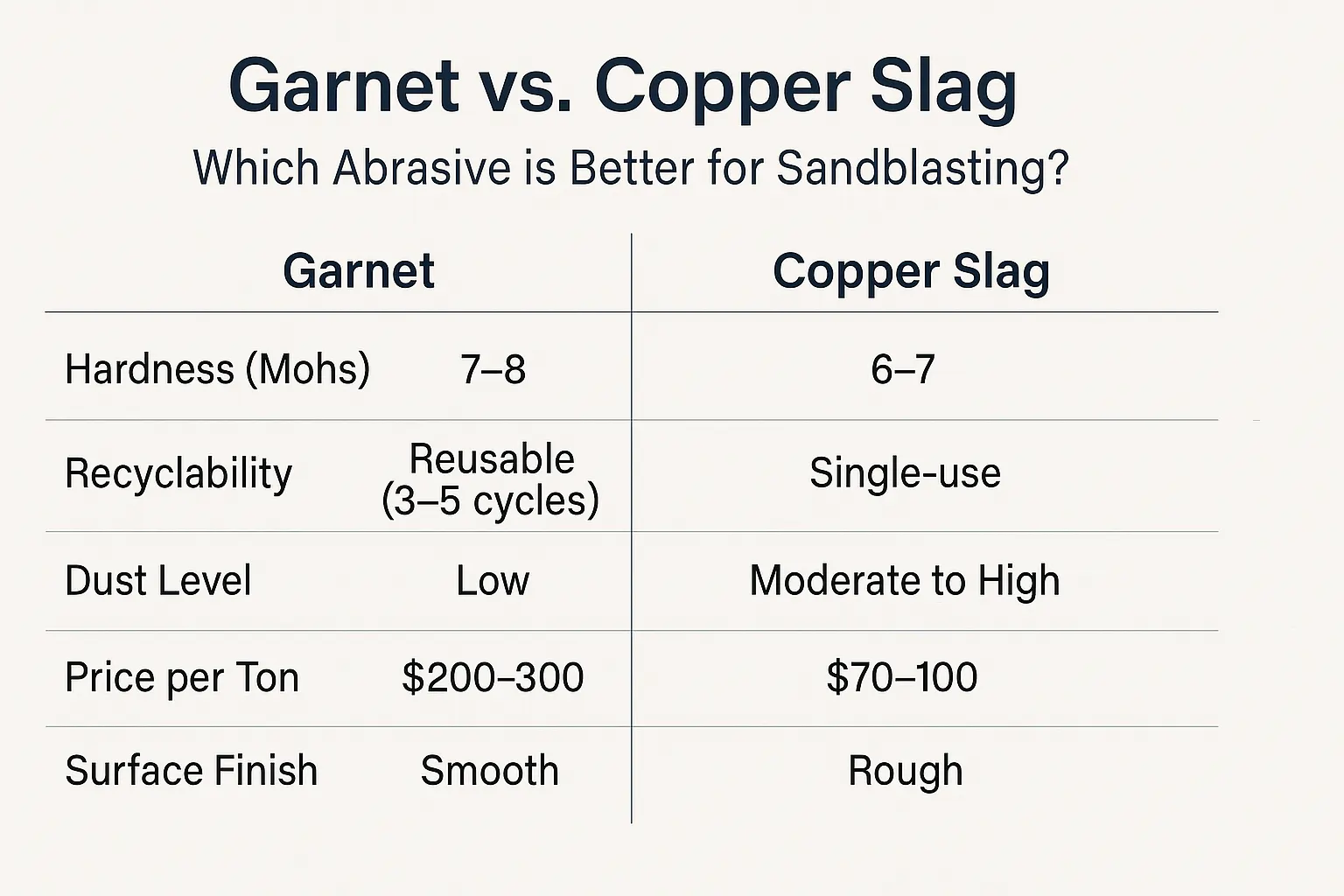In the world of surface preparation and industrial cleaning, sandblasting stands out as a vital technique. Choosing the right abrasive material can make all the difference in efficiency, cost, and environmental impact. This article compares garnet and copper slag, two popular options for sandblasting, to help B2B professionals in foreign trade and manufacturing make informed decisions. We'll explore their properties, advantages, drawbacks, and ideal applications, ultimately guiding you on which might suit your projects best.
Sandblasting, also known as abrasive blasting, is a process that propels fine particles at high speeds to clean, etch, or prepare surfaces. It's widely used in industries like shipbuilding, automotive, and construction for removing rust, paint, or contaminants. The choice of abrasive directly affects the outcome, including surface finish quality, project speed, and safety.
Abrasives vary in hardness, shape, and recyclability, impacting factors like material consumption and environmental footprint. For instance, softer abrasives may cause less damage but require more frequent replacement, while harder ones deliver faster results at potentially higher costs. Understanding these nuances is crucial for optimizing operations in global trade supply chains.
Garnet is a naturally occurring mineral known for its angular shape and high hardness, making it a top choice for precision sandblasting. Composed mainly of silicates, it's mined from deposits around the world and processed into various grit sizes for industrial use.
One of the key benefits of garnet is its low dust generation during blasting. This reduces visibility issues for operators and minimizes airborne particles, which is essential in regulated environments like shipyards or manufacturing facilities. Its durability also allows for multiple uses, potentially lowering long-term costs for bulk purchasers.
In summary, garnet shines in scenarios where precision and eco-friendliness are priorities, such as in precision engineering or when complying with strict environmental regulations.
Copper slag is a by-product of copper smelting, transformed into an angular, hard abrasive suitable for aggressive sandblasting tasks. It's widely available as a recycled material, appealing to cost-sensitive industries looking to minimize waste.
This abrasive is prized for its density and ability to handle heavy-duty applications, such as stripping paint from steel structures or preparing surfaces for welding. Its sharp edges provide rapid material removal, speeding up projects and boosting productivity in high-volume operations.
Overall, copper slag is best suited for industrial applications where speed and low initial costs outweigh environmental considerations, such as in heavy infrastructure projects.

When deciding between garnet and copper slag, several factors come into play, including cost, performance, safety, and sustainability. Let's break this down to help you evaluate based on your specific needs in foreign trade and manufacturing.
Copper slag typically has a lower purchase price, making it ideal for one-off or budget-limited projects. However, garnet's recyclability can lead to savings in the long run, especially for recurring sandblasting tasks. For B2B buyers, calculating total lifecycle costs is key to avoiding surprises in international shipments.
In terms of speed, copper slag often outperforms garnet on heavy rust removal due to its density. Garnet, on the other hand, provides a finer finish, which is preferable for applications requiring high precision, like in electronics or automotive parts manufacturing.
Garnet edges out in eco-friendliness, as it's a natural, non-toxic option with less dust. Copper slag, while recyclable in some contexts, may require more stringent handling to meet global standards like REACH or ISO certifications, which are critical for exporters.
Ultimately, the "better" abrasive depends on your project's scale, regulatory environment, and budget. Many professionals conduct trials to test both before committing to bulk orders.
Below, we address common queries from industry professionals to clarify key points about garnet and copper slag abrasives.
What is the main difference between garnet and copper slag in terms of hardness? Garnet typically scores higher on the Mohs scale (7-8) compared to copper slag (around 6-7), making garnet better for finer, more controlled blasting, while copper slag excels in brute-force applications.
Is garnet more environmentally friendly than copper slag? Yes, garnet is a natural mineral with minimal processing needs and lower toxicity, whereas copper slag may contain heavy metals, requiring careful waste management to comply with environmental laws.
Can I recycle copper slag for multiple uses? Copper slag is generally not recommended for recycling due to potential contamination buildup, unlike garnet, which can be reused several times with proper filtration systems.
Which abrasive is safer for worker health? Garnet produces less dust and fewer harmful particles, reducing respiratory risks, but both require PPE. Always follow OSHA guidelines for safe sandblasting practices.
How does cost compare for international buyers? Copper slag is cheaper initially, often under $100 per ton, while garnet might cost $200-300 per ton, but its longevity can offset expenses in high-volume trade scenarios.
What industries prefer garnet over copper slag? Industries like aerospace and marine, where precision and corrosion resistance are critical, favor garnet for its clean results and compliance with strict quality standards.
Can these abrasives be used in the same equipment? Yes, both can work with standard sandblasting machines, but adjusting pressure and feed rates is necessary to optimize performance and prevent equipment wear.
In conclusion, the choice between garnet and copper slag for sandblasting hinges on your specific operational needs, balancing factors like cost, efficiency, and sustainability. Garnet offers superior precision and eco-friendliness, making it ideal for high-end applications, while copper slag provides cost-effective power for demanding tasks. By evaluating these aspects, B2B professionals can enhance their foreign trade strategies and achieve better results. Always consider testing both options to ensure they align with your project's goals and regulatory requirements.
Tags: Black Silicon Carbide, White Fused Alumina, Brown Fused Alumina, Pink Fused Alumina, Black Fused Alumina